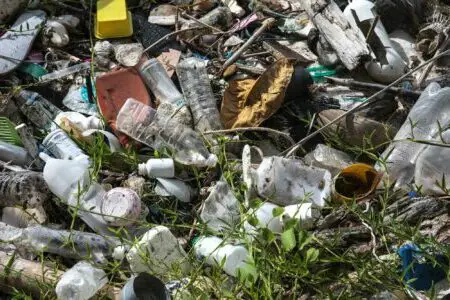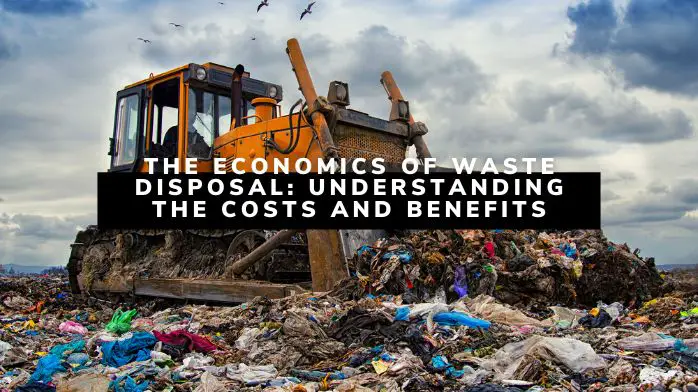Waste disposal refers to the actions taken to manage and dispose of waste materials. These waste materials can include both household and industrial waste. Proper waste disposal is important for public health and the environment. When waste is not properly disposed of, it can contaminate soil and water, leading to environmental pollution and public health problems. It can also contribute to climate change by releasing greenhouse gases, such as methane, produced when organic waste decomposes in landfills.
There are several options for waste disposal, including landfills, incineration, and recycling. Each option has its costs and benefits. The most appropriate method of waste disposal will depend on various factors, including the type of waste being disposed of, the availability of disposal facilities, and the costs of transporting the waste to these facilities.
Landfills are the most common method of waste disposal. They are relatively cheap, easy to build, and can be used to dispose of a wide range of waste materials. However, landfills can also negatively impact the environment, including the release of methane and other greenhouse gases, as well as the potential contamination of soil and water.
Incineration, or burning waste materials, is another option for waste disposal. Incineration can reduce the volume of waste by up to 90% and generate electricity. However, incineration can also release pollutants into the air, including carbon dioxide and other greenhouse gases.
Recycling is another option for waste disposal, and it can have significant environmental and economic benefits. Recycling reduces the need to extract raw materials, such as timber, oil, and minerals, which can help to conserve natural resources and reduce greenhouse gas emissions. In addition, recycling can create jobs and stimulate economic development. However, recycling can also be expensive and may not be practical or feasible for all waste materials.
The most appropriate method of waste disposal will depend on various factors, including the type of waste being disposed of, the availability of disposal facilities, and the costs of transporting the waste to these facilities. It is important to carefully consider the costs and benefits of each disposal option to choose the most effective and sustainable solution.
Landfills
A landfill is where waste materials, including household, industrial, and construction waste, are collected and buried. Landfills are typically lined with a layer of clay or plastic to help prevent waste from contaminating soil and water. Landfills are the most common method of waste disposal in many countries. They can be used to dispose of a wide range of waste materials, including paper, cardboard, plastic, glass, metal, food waste, yard waste, and construction debris.
Landfills can negatively impact the environment, including the release of methane and other greenhouse gases, as well as the potential contamination of soil and water. Methane is produced when organic waste materials, such as food and yard waste, decompose in a landfill. Methane is a powerful greenhouse gas that can contribute to climate change if released into the atmosphere. Landfills can also create unpleasant odors and attract pests like rats and birds.
Despite these negative impacts, landfills can also have some benefits. They are relatively cheap, easy to build, and can be used to dispose of a wide range of waste materials. In addition, landfills can create jobs and stimulate economic development.
It’s important to carefully consider landfills’ costs and benefits and consider alternative waste disposal methods, such as recycling and incineration, when possible.

Incineration
Incineration, or burning waste materials, is a method of waste disposal in which waste materials are burned at high temperatures to reduce their volume and destroy their harmful substances. Incineration can reduce the volume of waste by up to 90% and generate electricity. Incinerators, or waste-to-energy plants, can burn many waste materials, including household, industrial, and medical waste.
Incineration can have some environmental benefits. It reduces the amount of waste that must be disposed of in landfills, which can help reduce the negative impacts of landfills, such as the release of methane and the potential contamination of soil and water. In addition, incineration can generate electricity, which can be used to power homes and businesses.
However, incineration can also have negative impacts on the environment. It can release pollutants into the air, including carbon dioxide and other greenhouse gases, contributing to climate change. Incineration can also release particulate matter and other air pollutants, negatively impacting air quality and public health.
Incineration can be a useful method of waste disposal. Still, it is important to consider this method’s costs and benefits carefully and consider alternative waste disposal methods, such as recycling and landfills, when possible.
Recycling
Recycling is collecting and processing materials that would otherwise be discarded as waste and using them to create new products. Recycling can help to conserve natural resources, such as timber, oil, and minerals, and can also reduce greenhouse gas emissions by reducing the need to extract and process raw materials. In addition, recycling can create jobs and stimulate economic development.
Many materials can be recycled, including paper, cardboard, plastic, glass, metal, and electronic waste. The government can run recycling programs, private companies, or a combination. Recycling programs may be voluntary, in which individuals and businesses choose to recycle their waste materials, or mandatory, in which individuals and businesses are required to recycle certain materials by law.
Recycling can have some challenges and limitations. It can be expensive to collect and process recycled materials, and some materials, such as certain types of plastic, may not be feasible or practical to recycle. In addition, the quality of recycled materials may not be as good as that of new materials, which can limit their use in certain applications.
Recycling is an important option for waste disposal and can have significant environmental and economic benefits. It is important to consider the costs and benefits of recycling carefully and to implement effective recycling programs to conserve natural resources and reduce greenhouse gas emissions.
Conclusion
Waste disposal is managing and disposing of waste materials, including household and industrial waste. Proper waste disposal is important for public health and the environment, as it can help prevent soil and water contamination, reduce greenhouse gas emissions, and conserve natural resources.
There are several options for waste disposal, including landfills, incineration, and recycling. Each option has its costs and benefits.
The most appropriate method of waste disposal will depend on various factors, including the type of waste being disposed of, the availability of disposal facilities, and the costs of transporting the waste to these facilities. It is important to carefully consider the costs and benefits of each disposal option to choose the most effective and sustainable solution.

